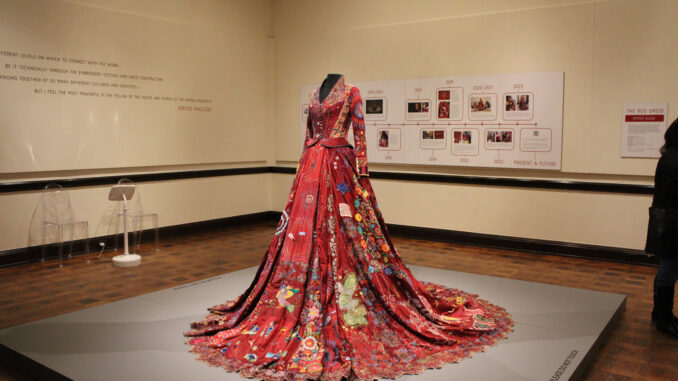
Kaitlyn Hughes | Staff Writer
“There are so many different levels on which to connect with the work — be it technically through the embroidery stitches and dress construction or the bringing together of so many different cultures and identities — but I feel the most powerful is the feeling of the voices and stories of the women involved,” read Kirstie Macleod’s words on the wall of the Frick Art Museum, alongside her traveling exhibit, ‘The Red Dress.’
As war, poverty and abuse contaminate our world, Macleod has created an outlet for women suffering hardships through her artistic and collaborative project.
This expressive enterprise has been on display at the Frick Art Museum since Oct. 7., and it will be open to visitors until Jan. 28.
The museum will host ‘The Red Dress Musical Celebration’ on its last day, which will include performances by musical groups Abbots Cross, Geña y Peña and Sanskruti.
The dress was a 14-year collaboration of 380 embroiderers from 51 countries and the project continues to support all 140 commissioned artisans by granting them a portion of the revenue generated by exhibition fees. More than one-third of contributors were refugees or members of poverty stricken families.
Macleod’s goal for the dress was to embody the identity of each individual embroiderer as they created their own unique design, reflecting their personal experiences and hardships.
Initially the project’s goal was just to bring people together, but as time went on the artist discovered the dress’ true significance: an expression of diverse cultures and identity, uniting individuals from around the world, a creative space for women’s voices to be magnified and apprehended and an observance of the universal language of embroidery due to its underappreciation.
“After the commissions had begun, and the dress began to form it became more and more obvious to me that the dress had the potential to be a platform to amplify vulnerable individual’s voices,” Macleod told Frick Art Museum. “Stories were being listened to [and] it was being noticed; therefore, it was a very good vehicle to try and help amplify those who were struggling to be heard.”
The message behind the dress was inspired by her experiences living abroad during her childhood. Originally born in Venezuela, Macleod moved to a different country every three years.
“We were very exposed to so many different cultures and ways of doing things – different languages, different customs, different foods, different colors, different textiles,” said Macleod. “It certainly did ignite in me this ongoing desire to keep on connecting and reaching out to different communities and cultures.”
The embroidery aspect of the project was influenced by Macleod’s personal experience with textiles.
Her grandmother was an experienced knitter and her mother made clothes for her and her sisters.
She was taught to embroider by an Indian teacher while living in Nigeria, which elevated her appreciation of the craft.
The message of the dress had a tremendous impact on many attendees, including Mary Sentesi.
“As I’ve been looking at this, I just thought of the women in the other countries that have faced adversity,” Sentesi said. “To be able to sit down and still use their creative instincts to pull this dress together, it really does show that we have this instinct of survival within us all.”
Respect for embroidery brought in many spectators at the Frick Art Museum; museumgoer Meg Hannan came to the exhibit because she enjoys sewing and creating quilts.
“It makes me feel like there is lots of good around the world because right now there is not so much,” Hannan said. “It’s bringing women together who don’t live the same lives as we do.”
To keep the underlying theme of the dress alive, Macleod encouraged each venue that hosts the Red Dress to create its own interpretation, called the Calico Dress, to gather the community together to collaborate in celebrating unity, diversity and self-expression.
Calico Dress No. 3 was worked on by 150 artists within three months.
Among the contributors were the Fiberarts Guild, Sibyls Shrine, Women of Visions, the Three Rivers Chapter of the Embroidery Guild of America, the Pittsburgh Lace Group, Frick summer campers, POWER, Studio Forget-Me-Not and refugee and immigrant support groups sponsored by Jewish Family and Community Services.
To keep the essence of connecting individuals, each artist was encouraged to incorporate designs that embodied their personal story and cultural identity.
Two artists from Sibyls Shrine, an art collective and residency program dedicated to supporting Black artists, incorporated art that represents members of their culture who were unable to express their own identity and the power they will use to overcome oppressing forces.
The Frick Art Museum also encouraged attendees to make contributions to the Calico Dress by drawing their own designs.
Pittsburgh resident Kathleen Moncure explained how the Calico Dress is a prime example of the Pittsburgh identity.
“We’re [Moncure and her husband] looking at the Calico Dress, and I’m thinking that this is a city where people’s stories are honored and people tell their stories in so many different ways,” she said. “It’s a storytelling city.”

